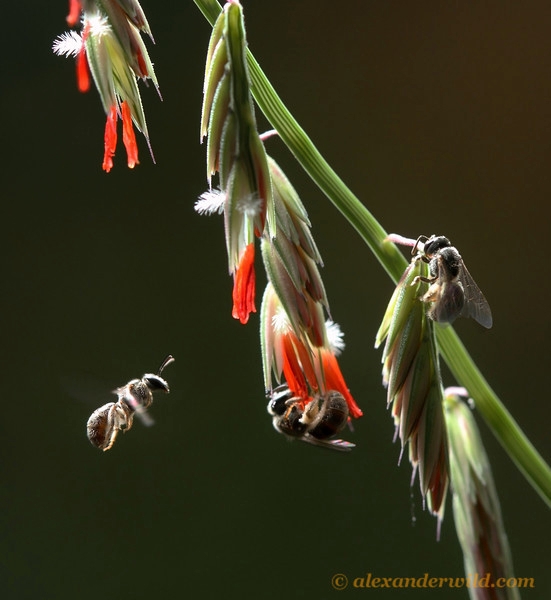- Author: Kathy Keatley Garvey

They look at us, and we look back.
But if you're Larry Snyder of Davis, an insect photographer and a retired musician, you not only look back, but you take their images.
Snyder does just that when he observes the insects at the city-owned North Davis Channel, the site of a former monarch-milkweed research project organized and directed by UC Davis professor Louie Yang. The site is also known as "the Covell drainage channel."
And now Snyder is sharing many of his images in a photography exhibit, "Insects at the Ditch," which opened Jan. 6 and continues through Feb. 2 at Logos Books, 513 2nd St., Davis.
The UC Davis research project began in December 2013 when Yang, a community ecologist, and his team planted narrow-leaved Asclepias fascicularis, at the site. Then they monitored the interactions of the monarchs, Danaus plexippus, on the plants from 2015 through 2017, culminating in the July 2022 publication of "Different Factors Limit Early-and Late-Season Windows of Opportunity for Monarch Development," in the journal Ecology and Evolution.
"I began watching, and then photographing, the insect life on the plants," Snyder related, adding that he became especially interested in insect behavior and interaction.
"It's my adopted back yard."
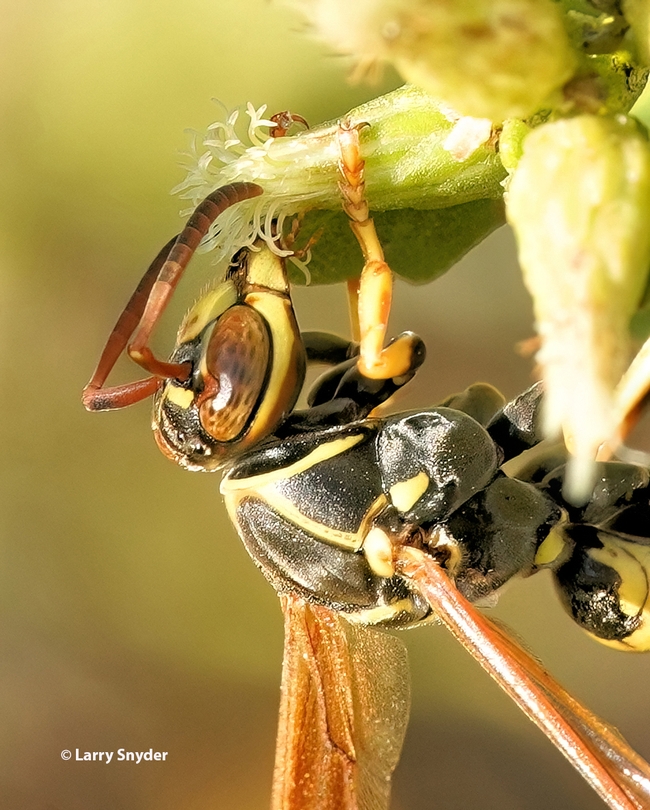
"I am grateful to the Bohart Museum of Entomology and its remarkable staff and associates for the frequent assistance in identification and understanding of life in the insect world." He has also shared his images with the Bohart Museum.
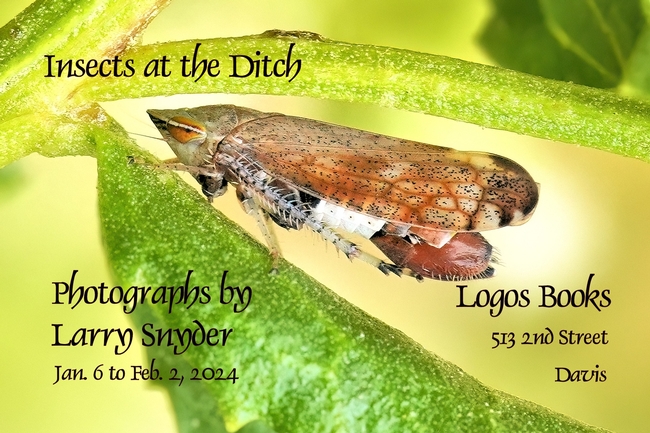
He directed the opera from 1976 to 2000. He also published a book, German Poetry in Song, in 1995. In 2001 he chaired the organizing committee for The Davis Star Show astronomy festival.
Snyder's last photography show (of 5x7 black and white contact prints) was at the old Davis Art Center in 1985. He recalls using a "5x7 Deardorff, one of those things resembling an accordion on stilts, rather unsuited for living macro subjects, and which I sold 25 years ago."
As the late E. O. Wilson said: "It's the little things that run the world."
(Editor's Note: The Bohart Museum, home of a global collection of eight million insects, is located in Room 1123 of the Academic Surge Building, 455 Crocker Lane, UC Davis. The Bohart Museum's next open house, themed "Social Wasps," is from 1 to 4 p.m., Saturday, Jan. 20. It is free and family friendly. UC Davis distinguished professor Lynn Kimsey, director of the Bohart, will share her wasp expertise.)
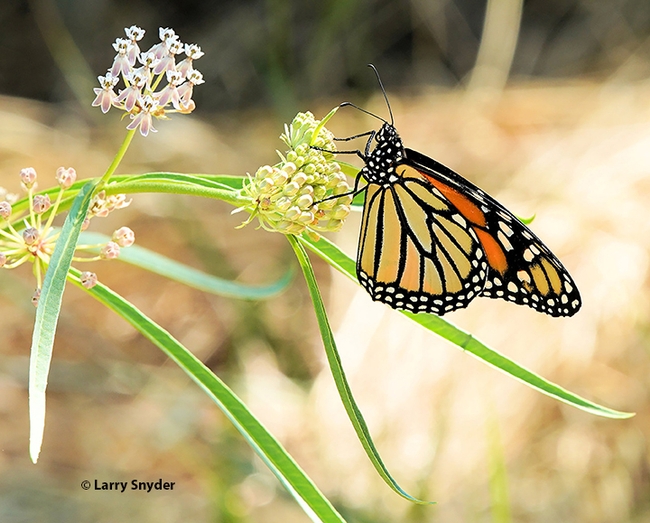
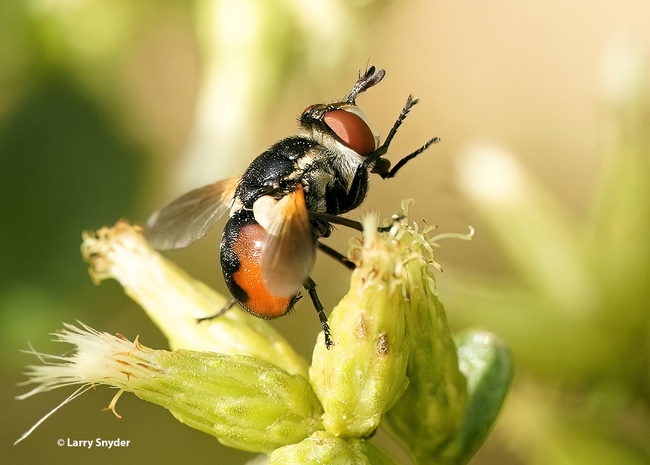
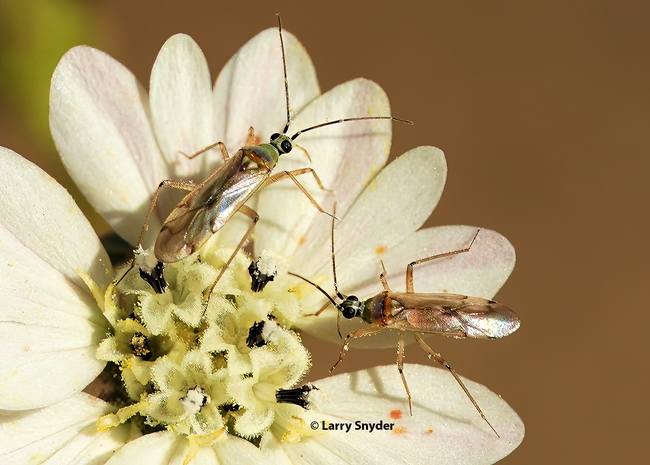
- Author: Kathy Keatley Garvey
If you're addicted to insects or insect photography, you'll want to see the international award-winning images on the Insect Salon website. Each year the Peoria (Ill.) Camera Club hosts the contest in conjunction with the Entomological Society of America (ESA).
The subjects are primarily insects but can also include spiders and related arthropods, such as barnacles, crabs, lobsters, shrimp, centipedes and millipedes. For your work to be accepted in the Insect Salon showcase, it must score at least 12 points. Those who score 15 are selected medalists.
The ESA, a professional insect-science organization of some 7000 members, showcases these images at its annual conferences. This year's conference, set Nov. 5-8 in Denver, Colo., is appropriately themed "Ignite. Inspire. Innovate."
The winning photographers this year represent 16 countries: Argentina, Australia, Belgium, Brazil, Canada, Finland, France, Germany, Italy, Malayasia, Slovenia, South Africa, Taiwan, United Arab Emirates, United Kingdom and the United States. Some images are from ESA members, and some are from alumni of the BugShot Macro Photography Workshops.
Malaysia-based photographers anchored the winners' circle:
- The best-of-show medal went to Tommy Teh of Malaysia for "Hunger For Food 3"
- The medal for most unusual: Andrews Ruggen of Argentina for "Convivencia"
- The medal for best storytelling: Alek Low of Malaysia for "Craving For Food"
- The medal for best image from a non-ESA member: Kawawa Wong Yik Siang of Malaysia for "Hungry Jumping Spider"
- The medal for best image from an ESA member: Wei Fu of Ontario, Canada for "Bite Tightly"
- The medal for best image from a Peoria Club Camera member: John Weidman of Peoria, Ill. for "Argiope Securing Grasshopper"
You can view them all by accessing the Insect Salon website and then clicking on the image titles. The site includes the name of the photographer, city/country of residence, and the title of the image.
Due to copyright concerns, I'm not posting the winning images, but posting two of mine that were accepted for the 2017 Insect Salon showcase:
- "Faster than a Speeding Bullet" shows a long-horned bee (Melissodes agilis) in flight, speeding over a Mexican sunflower (Tithonia rotundifolia). This image received one of the 19 honorable mentions. (Image taken with a Nikon D500 camera with a 70-180mm lens. Settings: ISO 2500, f-stop 16, and shutter speed of 1/1000 of a second)
- "Under Attack!" shows a long-horned bee (Melissodes agilis) targeting a Red Admiral butterfly (Vanessa atalanta), also on Tithonia. (Image taken with a Nikon D500 with a 70-180mm lens. Settings: ISO 2000, f-stop 7, and shutter speed of 1/3200 of a second.)
These might inspire you to enter the 2018 Insect Salon competition.
It's a Macro World out there!
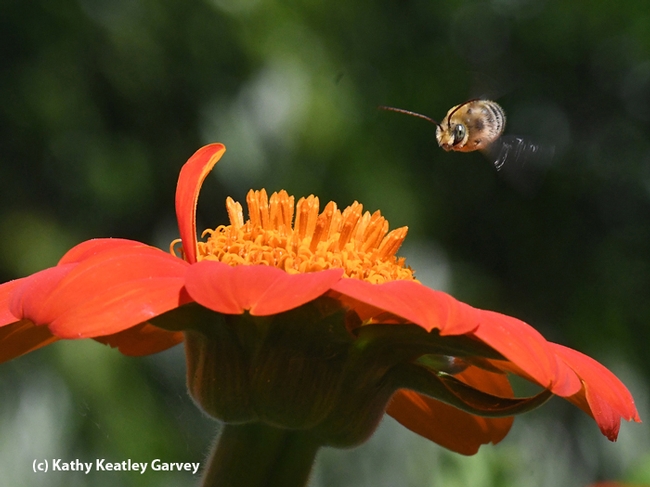
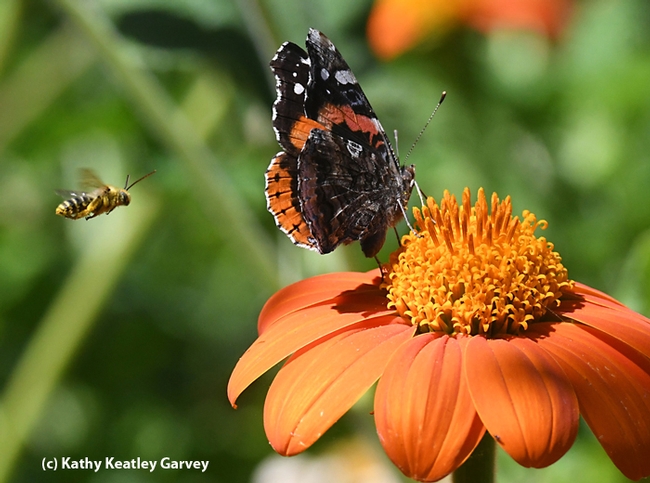
- Author: Kathy Keatley Garvey
Goodbye, 2013. Hello, 2014.
If you're a beginning driver--or you remember being a beginning driver--your instructor may have admonished: "Look where you're going; not where you've been."
But sometimes, especially at the end of a year, it's good to know where you've been.
Or, in the case of arthropod photography, where the insects and spiders hung out.
If you're like me, you like to prowl their habitats. Sometimes I walk softly and carry a big stick (tripod) but most of the time, I just walk softly.
I focus on their eyes. Their eyes. Their eyes look back at me. Predator or prey? Ignore or confront? Fight or flee?
Not to worry. I am a visitor in their home. I don't poke 'em, prod 'em or pin 'em.
Thankfully, our bee friendly garden in our backyard is not only friendly to bees, but flies, such as robber flies, bee flies and syrphids. The bees? Honey bees, carpenter bees, leafcutting bees, blue orchard bees, sweat bees and European wool carder bees. We see scores of other insects, too, including lady beetles, butterflies, dragonflies, praying mantids, lacewings, and the like. We also welcome arachnids, such as crab spiders, cellar spiders and jumping spiders. We all live together, sometimes not so peacefully. Sometimes not at all. Nature is what it is. And we are what we are. (See some of Bug Squad's favorite images of 2013.)
If you love insect photography, you'll love entomologist/insect photographer Alex Wild's blog, Compound Eye, on scientificamerican.com. (Every time I think of Scientific American, my mind fades back to my high school science project selected for the Pacific Northwest Science Fair at the Oregon Museum of Science and Industry. It won a year's subscription to the magazine. Memories...)
We at the UC Davis Department of Entomology and Nematology know Alex Wild as not only an amazing photographer, specializing in ants, but an alumnus. He received his doctorate here, studying with Professor Phil Ward, a noted ant specialist.
The Compound Eye blog describes him this way: "Alex Wild is an Illinois-based biologist who studies insect evolution. He picked up photography a decade ago to better illustrate his technical presentations, and shortly thereafter found himself running a business supplying books, magazines, and museum exhibits with close-up images of insects and other micro-wildlife. Alex holds a Ph.D. in entomology from the University of California at Davis and currently teaches and conducts research at the University of Illinois at Urbana-Champaign. His scientific work includes descriptions of new insect species, annotations of insect genomes, and monographs on the evolution of various groups of wasps, beetles, and ants. Compound Eye is Alex's exploration of science photography's challenges and the role images play in science communication. Alex's galleries are available at http://www.alexanderwild.com." (He also writes the Myrmecos blog and co-teaches the BugShot photography workshops.)
Wild's Compound Eye blog today (Dec. 31) showcases some of the work of noted nature and science photographers. He asked them for links to their "best Nature & Science images from the past year, and wow--you did not disappoint!"
While you're toasting the New Year, offer a toast to these images!
You will be awestruck! Best of all, maybe you'll pick up a camera and start photographing insects, too...






- Author: Kathy Keatley Garvey
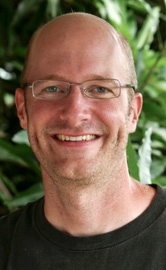
There are those who point and shoot, those who shoot and point, and those who see the world through a viewfinder.
And then there's Illinois-based Alex Wild, who is in a class by himself. He's an evolutionary biologist turned full-time science photographer whose visual explorations of insect natural history appear in numerous magazines and textbooks, on websites, and in museum exhibits.
Wild also runs photography workshops, teaches entomology and beekeeping at the University of Illinois at Urbana-Champaign, and blogs for Scientific American.
He's an amazing photographer, Alex Wild is. His work has been showcased in the New York Times, National Geographic and Scientific American, among others.
Wild, who received his doctorate in entomology in 2005 from the University of California, Davis, with major professor and ant specialist Phil Ward, will be on the UC Davis campus on Wednesday, Oct. 26 to speak on "How to Take Better Insect Photographs" from 12:10 to 1 p.m. in 122 Briggs Hall.
This is his first visit to the campus since 2005 and he says "I can't wait."
Neither can all the folks eager for his tips on insect photography and an opportunity to view some of his spectacular photos.
"I am aiming this talk specifically at graduate students," Wild writes on his blog, Myrmecos (derived from the ancient Greek word for ant). "Because scientists use images in many applications--from lab websites to posters and presentations--and because cameras are so available and inexpensive, I think basic photography should be as much a part of academic training as learning to assemble a poster or a conference talk. Thus, 50 minutes on simple tips for taking better photos.”
"I do hope those of you within easy travel distance can attend," he adds.
When you access his Myrmecos blog and his Alex Wild Photography portfolio, you'll be transported into the fascinating world of insects. It's not just a journey; it's a trip. A delightful, exciting, inspiring, educational and informative trip.
One of Alex Wild's favorite photographs (below) shows Lasioglossum sweat bees gathering pollen from sideoats grama (Bouteloua curtipendula). He captures a moment in time, and time in the moment.
One more thing: if you miss Alex Wild's UC Davis lecture, not to worry. Entomology professor James R. Carey plans to webcast it and post it on UCTV.
